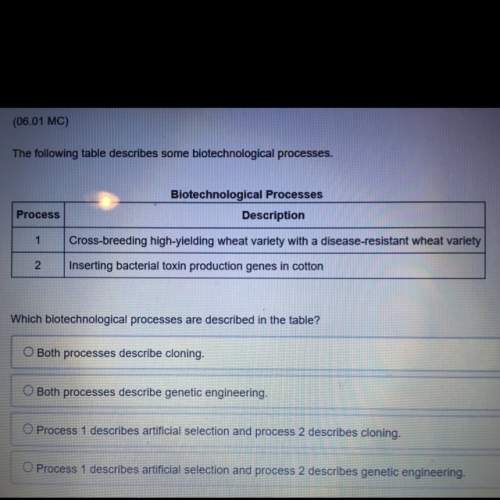
Biology, 03.05.2021 06:10 krystalhurst97
Design a hypothetical experiment and write a short prompt to describe how you would go about conducting such an experiment from start to finish, including how you would grow cells, how to prepare them for RNA-seq, and what you would do after you have obtained raw gene counts. Please include step by step of your experiment. Example: I work in a microbial bioengineering lab which focuses on production of metabolites with high-added value. Our lab currently has established media on which our microbe grows; however, we have 5 experimental growth substrates which we predict can give us better yields, in comparison to our standard media. The way I would approach this scenario is growing our bacterial strain, in triplicate, on our standard media and all 5 experimental growth substrates. I would ensure all other factors remain static (growth time, growth temperature, amount of biomass used to inoculate) and harvest cells at the end of their incubation. After harvesting cells, I would extract mRNA using an established kit and prepare samples for cDNA library construction/RNA sequencing. After I receive my raw FASTQ reads, I would either use an established bioinformatic pipeline or an existing pipeline to obtain raw gene counts, at which point I would conduct differential gene expression analysis with DESeq2 to get an overview of which genes are up- or down-regulated, relative to our standard growth media. Subsequently, I suspect that genes in the TCA cycle and pentose phosphate pathway (PPP) will be the most impacted; I take the results of my differential gene expression analysis and use them as input for pathView to check which enzymes/enzymatic reactions are being influenced, relative to our standard growth media.

Answers: 2


Another question on Biology

Biology, 22.06.2019 04:00
Why are fossils not found in igneous rocks? igneous rocks are made from cooling of lava or magma. igneous rocks are found too deep underground. igneous rocks are too dark in color to contain fossils. igneous rocks are too dense to contain fossils.
Answers: 2

Biology, 22.06.2019 05:00
Idon’t know the answer and i’ve been stuck on it for a while now skskskskks
Answers: 1

Biology, 22.06.2019 09:00
Hurry i need your (100 points) 1) what are the responsibilities of the region of the brain highlighted below? (picture located below) the highlighted portion is at the rear base of the brain, behind the brain stem. regulating homeostasis, hunger and eating, thirst and drinking, and many other functions of basic survival. coordinating movement and balance by using information from sensory nerves, including hand-eye coordination. controlling voluntary body movements, processing information from sense organs, thoughts, and learning abilities. regulating important involuntary bodily functions such as blood pressure, heart rate, breathing, and swallowing. 2)which of the following systems or structures is correctly paired with its function? neurons - brain cells that control thoughts, calculations, and memory cerebral cortex - portion of the brain that controls involuntary body movement peripheral nervous system - carries impulses to and from the central nervous system central nervous system - carries information from the nerves to the muscles and glands
Answers: 1

Biology, 22.06.2019 13:10
Which of the following is not a benefit of genetically modified foods? a.pest-resistant crops b.herbicide-resistant crops c.plants that do not require water?
Answers: 2
You know the right answer?
Design a hypothetical experiment and write a short prompt to describe how you would go about conduct...
Questions


Mathematics, 20.12.2019 03:31

Mathematics, 20.12.2019 03:31

Mathematics, 20.12.2019 03:31



History, 20.12.2019 03:31

Mathematics, 20.12.2019 03:31



Biology, 20.12.2019 03:31



Biology, 20.12.2019 03:31

Mathematics, 20.12.2019 03:31



Physics, 20.12.2019 03:31


Biology, 20.12.2019 03:31




